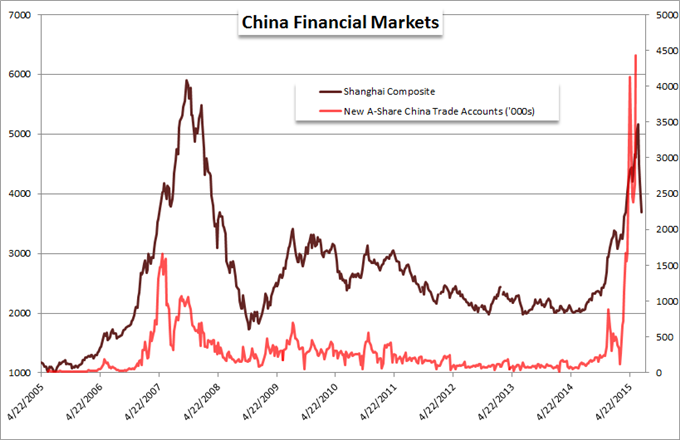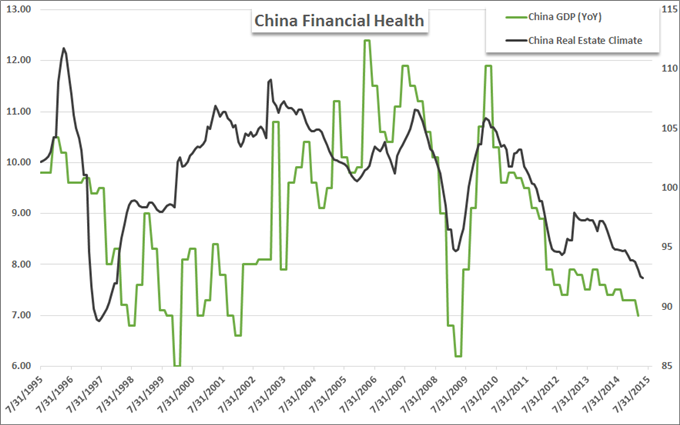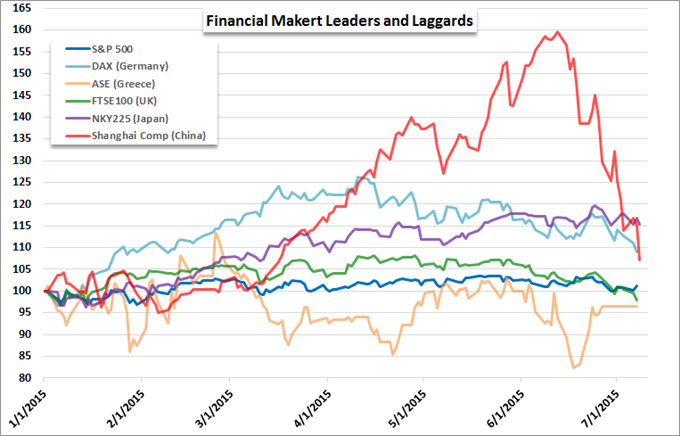Chinese markets have been battered the past four weeks. Heavy selling has plagued the country’s equity market despite intrepid efforts by regulators and the government to try to halt the panic. Wednesday’s open was no different. Gauging overnight sentiment and fearing another plunge was awaiting the start of trade, the China Securities Regulatory Commission (CSRC) reportedly took the incredible step of freezing trade on 43 percent of shares in the entire stock market.
Despite the effort, the Shanghai Composite and CSI 300 would still open the day sharply lower. The opening move for the benchmark index was a painful 7 percent. With market limits in place, many shares would hit the 10 percent limit down boundary that would halt trading for the rest of the session (not to reopen until the following day). By some estimates, between pre-open freezes and session limits, 89 percent of the market was closed.

By the time the opening move was finished in the morning session, day’s losses nudged the total decline from the June 12 peak to 34 percent. As of this past Friday, the three-week decline seen in the Shanghai Composite was the biggest cumulative loss in such a short period since 1992. There is worrying momentum and breadth behind this move which threatens to feed a bigger fire in the market and potentially spread to the global financial system.
Support that is Falling Short
What is truly concerning is that this tumble continues through a wealth of rescue efforts that authorities have enacted these past weeks. Over the weekend of June 27, a ‘traditional’ move was made by the People’s Bank of China when it announced a 25 basis point cut to the one-year deposit rate to 4.85 percent. Thereafter, the efforts grew more unorthodox. This past weekend, China’s largest brokers announced they would jointly invest 15 percent of their net capital in the equity market with mutual funds following suit soon after.
Adding more capital to bolster stability seems to be the favored approach. The country’s Sovereign Wealth Fund was reportedly tapped to add capital to the system (even before the broker effort) and the China Securities Finance Corporation announced this morning that it is seeking over 500 Billion yuan to support the market.
Perhaps too late, regulators have also taken steps to curb speculative interests – in case sentiment recovers – by introducing curbs on margin trading and by freezing IPOs.
The Underlying Problem
The government’s efforts are sizable, and the support is likely to grow further going forward. However, the bigger issue is one of moral hazard and a general bubble within the Chinese financial system. From a moral hazard perspective, the run in capital markets that had it soundly outpace its global counterparts up until this past month was fed by exuberant speculative appetite. In the graphic below, we see the Shanghai Composite’s incredible surge alongside the number of new A-Share (local) trading accounts opened on a weekly basis.

Media covered well, the type of trader that was jumping in on the market. Many had little-to-no experience in equity markets, and few had experience with a modest market correction – much less a major retracement. Further complicating the matter, the appetite for equities came alongside an opening of margin trading (borrowing funds to speculate). Leverage is a normal tool for developed markets, but it can also fan instability in retracements.

Bubbles in China
Though there are many definitions as to what constitutes a ‘bubble’, it would be disingenuous to not say China’s stock surge through June was a bubble. After the ‘when’ evaluation for when such an over-inflated market pops, the question then turns to ‘how far’ it deflates. That depends on scale of deleveraging necessary and the regulators’ efforts in the face of potentially fanning moral hazard. Speculators crowded into the recently opened stock market in hopes of making quick and dramatic returns. The influx was so significant that has been estimated 4 out of 5 investors in the market are individuals with less experience and means.
Given the socioeconomic impact of the losses suffered by the new demographic of equity investor, officials have little option but to try and prop up the market. However, this is an increasingly familiar effort that can feed further excessive risk taking and fuel future bubbles. This equity bubble is only the latest in a string of excess in other sectors over the past years. Economic controls, government subsidies and access to cheap funds led to bubbles in real estate and credit markets. Recognizing a coming wave of non-performing loans (NPLs), regulators started to clamp down. It is still not clear if these other areas are saved, slowly deflating or destined to come to a problem in the future.

Contagion Risk
The risk arising in the Chinese financial system doesn’t stop at the country’s economic borders. While there are significant breaks in between China and its global counterparts – to help maintain stability in its command-to-managed approach economy – sentiment doesn’t stop with capital barriers. China was an economic leader and the picture of stability through the Great Financial Recovery and its early years of recovery. Its most recent run up has also marked a level of optimism that there was still value to be found around the world.
However, through 2015, skepticism has garnered greater traction amongst the speculative ranks. And, many global benchmarks held back as the Shanghai Composite rocketed higher. In the subsequent tumble, we have yet to see other regions suffer any near the same extent. However, the losses will start to pass through via direct investment, assets developed to mirror local benchmarks and through shared Emerging Market confidence. When we start to see fear spread to the world’s largest market barometers, the situation will significantly deteriorate. Keep an eye on the Nikkei 225, FTSE 100 and S&P 500 to gauge the contagion.


